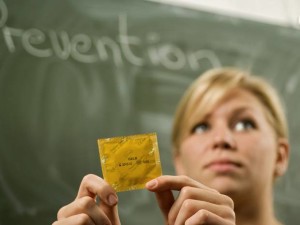I pulled a student into the hallway while her classmates read silently. At the beginning of the year, she had been sweet, receptive, and hard-working. More recently, she was combative and lashing out. “So,” I asked her, “what’s changed?”
Tears started. She had begun having sex, her mother found out, gave her a “whooping,” and took away her daughter’s condoms. That didn’t stop this student’s sexual activity but, she said, she was being careful. Each time she had sex — once every few weeks — she would take the morning-after pill.
I was more flabbergasted by her frequent use of emergency contraception than by her sexual activity. Didn’t she know how the morning-after pill works? Didn’t she realize she was delivering massive amounts of hormones to her still-developing teen body? Wasn’t this covered in her sex-ed class?
Probably not. This was 2010, and from 1995 to 2009, North Carolina offered abstinence-only-until-marriage education (with some schools discussing STDs).
But starting in fall of 2010, NC schools were required to implement curriculum that met the Healthy Youth Act, which “aligns more closely with parent opinion and public health best practices.”
Because I had no idea what that sentence means, I started researching the Healthy Youth Act. I was relieved to learn that North Carolina isn’t screwing its students quite as much as before, but it still has a ways to go.
Jenny Palmer, the School Engagement Specialist for Adolescent Pregnancy Prevention Campaign of North Carolina, says that, in practice, most students receive the Reproductive Health and Safety Education (sex-ed) curriculum in ninth grade.
However, NC students are only required to receive one health and one physical education credit. I know plenty of students who are upperclassmen before they take the class in which sex-ed is covered. Why not rework student schedules so that they are required to take it during their ninth or tenth grade year?
And while we’re reconfiguring students’ schedules, maybe we should revamp the curriculum so that sex- ed is its own course. Right now, >>the NC health course has three standards (out of fourteen) that cover “Interpersonal Communications and Relationships.” Those three standards are further broken down into eleven sub-standards. That’s a lot of vital information to cover in a few weeks.
Even if the teacher has the best of intentions, she can’t, with any depth, cover all of the information, so she picks what she feels is most important or what she is most comfortable with, leading to inconsistencies in student education.
Also, up-to-date medical knowledge is necessary. While the reproductive system doesn’t change, contraceptives, STDs, and the way we view sexuality and gender identity do (>>even though it’s still not required that sexual orientation be taught at all). Yet we don’t require teacher training to cover this information.
My guess is that one of the main reasons we don’t make these changes is the expense of providing more classes, more teachers, and more professional development.
Another reason is priority. As Palmer pointed out, “education policy is in such turmoil that it’s easy to lay aside topics that aren’t as much in focus.”
I say let’s get it back in focus, because, like Palmer notes, a student’s academic success hinges on her health success. Also, to keep teen pregnancy rates dropping, education and access to healthcare go hand in hand.
>> Jennifer Brick is a writer and teacher in Durham, North Carolina. She earned her Masters of Fine Arts in Creative Nonfiction from Goucher College. Follow her on Twitter @jenbrickwrites.
Jennifer Brick is a writer and teacher in Durham, North Carolina. She earned her Masters of Fine Arts in Creative Nonfiction from Goucher College. Follow her on Twitter @jenbrickwrites.

There are no comments
Add yours